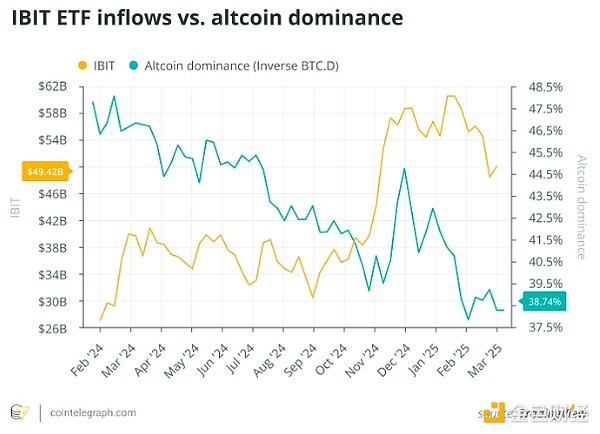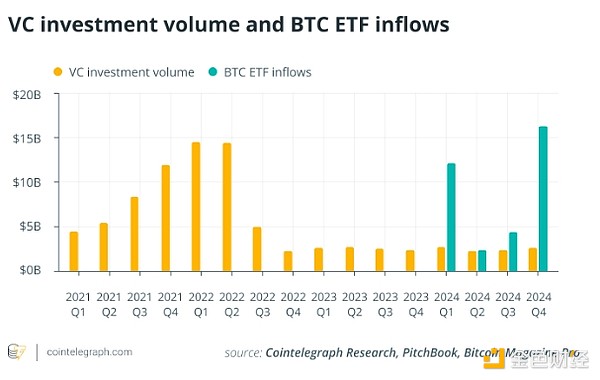Is the copycat season over? Bitcoin ETFs to rewrite cryptocurrency investment strategy

Reprinted from jinse
03/12/2025·1MAuthor: Michael Tabone, CoinTelegraph; Translated by: Deng Tong, Golden Finance
Bitcoin exchange-traded products may fundamentally change the concept of cryptocurrency "copy season".
For years, the cryptocurrency market has followed a familiar rhythm, the almost predictable dance of capital rotation.
However, this cycle once taken for granted shows signs of structural collapse.
Spot Bitcoin Exchange Trading Funds (ETFs) broke the record, inflowing $129 billion in capital in 2024. This provides unprecedented access to Bitcoin for retail and institutional investors, but also creates a vacuum that sucks away capital from speculative assets. Institutional participants now have a secure, regulated way to reach cryptocurrencies without the risk of altcoin market. Many retail investors have also found ETFs to be more attractive than the dangerous pursuit of finding the next 100x token. The well-known Bitcoin analyst Plan B even traded his actual BTC for spot ETFs.
This shift occurs in real time, and altcoins will face a decrease in market liquidity and correlation share if capital remains locked in structured products.

Is the altcoin season over? The rise of structured cryptocurrency
investment
Bitcoin ETFs provide an alternative to chasing high-risk, low-market capital assets, as investors can gain leverage, liquidity, and regulatory transparency through structured products. Retail investors, once the main driver of altcoin speculation, now have direct access to Bitcoin and Ethereum.
Institutional investors have greater motivation to avoid altcoin risks. Hedge funds and professional trading departments once chased higher returns from less liquid altcoins, and now they can deploy leverage through derivatives or invest through ETFs on traditional financial tracks.
With the ability to hedge through options and futures, the motivation to bet on altcoins with poor liquidity and low trading volume has been greatly weakened. This is further confirmed by a record $2.4 billion outflow in February and arbitrage opportunities created by ETF redemptions, forcing cryptocurrency markets to become unprecedentedly disciplined.

The traditional “cycle” begins with Bitcoin and then enters the altcoin season. Source: Cointelegraph Research
Will venture capital give up on cryptocurrency startups?
Venture Capital (VC) companies have traditionally been the lifeblood of a rotation season, injecting liquidity into emerging projects and crafting a grand narrative around emerging tokens.
However, because leverage is easy to access and capital efficiency is a priority, venture capital firms are rethinking their approach.
Venture capital firms seek to get as much return on investment (ROI) as possible, but the typical range is between 17% and 25%. In traditional finance, risk-free capital rates are the benchmark for measuring all investments, usually expressed in U.S. Treasury yields.
In the cryptocurrency space, Bitcoin’s historical growth rate serves as a similar benchmark for expected returns. This actually becomes the industry version of the risk-free interest rate. Over the past decade, Bitcoin’s compound annual growth rate (CAGR) averaged 77% over the past decade, far exceeding traditional assets such as gold (8%) and the S &P 500 (11%). Even in the past five years, both bull and bear markets, Bitcoin has maintained a CAGR of 67%.
Using this as a benchmark, venture capitalists who invest in Bitcoin or Bitcoin-related businesses at this growth rate will receive a total return on investment of about 1,199% in five years, meaning investment will increase by nearly 12 times.
Although Bitcoin remains volatile, its long-term outstanding performance makes it the basic benchmark for evaluating risk-adjusted returns in the crypto space. With arbitrage opportunities and reduced risks, venture capital firms may make safer choices.
In 2024, the number of venture capital transactions fell by 46%, although overall investment rebounded in the fourth quarter. This suggests that investment will shift to more selective and valuable projects rather than speculative financing.
Web3 and AI-powered crypto startups are still compelling, but there are days to indiscriminately finance every white paper-based token. If venture capital moves further to structured investment through ETFs rather than directly investing in high-risk startups, the consequences can be serious for new altcoin projects.
Meanwhile, a few altcoin projects that have entered the institutional horizon—such as Aptos, which recently submitted ETF applications—are exceptions, not the norm. Even crypto-index ETFs designed to gain a wider range of investment opportunities have difficulty attracting meaningful capital inflows, highlighting that capital is concentrated rather than decentralized.

Oversupply problem and new market reality
The situation has changed. The number of altcoins that are competing for attention has caused saturation problems. According to Dune Analytics, there are currently more than 40 million tokens on the market. An average of 1.2 million new tokens are issued per month in 2024, and more than 5 million tokens have been created since the beginning of 2025.
As institutions tend toward structured exposure and lack retail-driven speculative demand, liquidity does not flow to altcoins as it used to be.
This raises the cruel fact: Most altcoins cannot survive. CryptoQuant CEO Ki Young Ju recently warned that most of these assets are unlikely to survive without a fundamental shift in the market structure. “The era of everything going up is over,” Ju said in a recent X post.
In an era when capital is locked in ETFs and perpetual contracts rather than free flowing into speculative assets, traditional strategies to wait for Bitcoin’s dominance to weaken before turning to altcoins may no longer apply.
The cryptocurrency market is no longer the same. The era of relaxed, cyclical altcoin rebound may be replaced by an ecosystem where capital efficiency, structured financial products and regulatory clarity determine the flow of funds. ETFs are changing the way people invest in Bitcoin and fundamentally change the liquidity distribution across the entire market.
For those who build on the assumption that there will be an altcoin boom after every bitcoin rebound, it may be time to rethink. As the market matures, the rules may have changed.



 chaincatcher
chaincatcher
 panewslab
panewslab